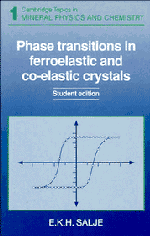Book contents
- Frontmatter
- Contents
- Errata
- Preface
- A brief guide for the reader
- 1 Introduction and some definitions
- 2 Ferroelastic and co-elastic phase transition
- 3 The Landau potential
- 4 The spontaneous strain
- 5 Coupling between the spontaneous strain and the order parameter
- 6 Macroscopic classification of ferroic and co-elastic crystals
- 7 Ferroelastic and co-elastic twin structures
- 8 Domain mobilities and elastic instabilities in ferroelastic and co-elastic materials
- 9 Specific heat anomalies and the excess entropy
- 10 Coupling between order parameters in ferroelastic and co-elastic crystals
- 11 Gradient coupling and strain modulations
- 12 Some aspects of the kinetic behaviour of ferroelastic and co-elastic crystals: an outlook
- References
- Appendix: An atomistic model for the Landau potential and the origins of the saturation effect
- Index
4 - The spontaneous strain
Published online by Cambridge University Press: 03 May 2011
- Frontmatter
- Contents
- Errata
- Preface
- A brief guide for the reader
- 1 Introduction and some definitions
- 2 Ferroelastic and co-elastic phase transition
- 3 The Landau potential
- 4 The spontaneous strain
- 5 Coupling between the spontaneous strain and the order parameter
- 6 Macroscopic classification of ferroic and co-elastic crystals
- 7 Ferroelastic and co-elastic twin structures
- 8 Domain mobilities and elastic instabilities in ferroelastic and co-elastic materials
- 9 Specific heat anomalies and the excess entropy
- 10 Coupling between order parameters in ferroelastic and co-elastic crystals
- 11 Gradient coupling and strain modulations
- 12 Some aspects of the kinetic behaviour of ferroelastic and co-elastic crystals: an outlook
- References
- Appendix: An atomistic model for the Landau potential and the origins of the saturation effect
- Index
Summary
The central physical feature of ferroelastic and co-elastic crystals is their lattice distortion which is described by the ‘spontaneous strain’. It is essential that the reader can deal with this quantity.
The order parameter and the Landau potential have been introduced in a fairly general manner without any restriction on ferroelastic or co-elastic phase transitions. The structural meaning of the order parameter Q can be related to the softening of an acoustic mode, an optical soft mode, an orientational ordering process, a cation exchange process or any other structural feature which is correlated with the phase transition. In order to make the phase transition ferroelastic or co-elastic, it is necessary that the transition mechanism changes the shape of the crystal in order to create a macroscopic spontaneous strain. We have seen that this macroscopic spontaneous strain is strongly influenced by the domain structure of the crystal. Although the domain effects are relevant to the macroscopic appearance of the mineral, they often do not contribute enough energy towards the total Gibbs free energy to influence the transition mechanism significantly. If microstructures are ignored as a first approximation, we can replace the macroscopic spontaneous strain by the structural spontaneous strain which is usually simply called the spontaneous strain. We shall come back to the question of microstructures in Chapter 7. This quantity is measured as the volume average of the structural deformation of the unit cell; its analytical form was first introduced by Aizu (1970) for ferroelastic systems.
- Type
- Chapter
- Information
- Publisher: Cambridge University PressPrint publication year: 1991

